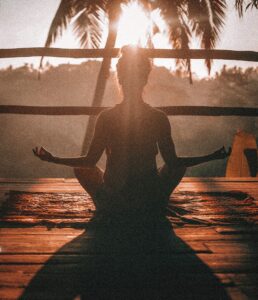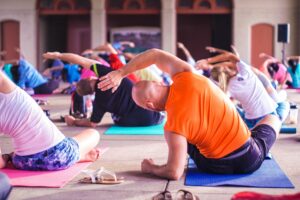Try this Dynamic Yoga Style to Have a Holistic Approach to Your Health
Ashtanga Yoga is a dynamic and physically demanding style of yoga that is popular worldwide.
This ancient practice has its roots in Indian yoga traditions and was popularized by the modern-day yogi Sri K. Pattabhi Jois in the 20th century.
Jois was a student of T. Krishnamacharya, who is known as the father of modern yoga.

His approach was a holistic one.
Joining ayurveda medicine, breathing, meditation, and exercise he created a method for boosting your health and well-being.
Origins of Ashtanga Yoga
T.Krishnamachary
Tirumalai Krishnamachary (1888-1989) was an Indian yoga teacher and scholar widely regarded as one of the most influential figures in the modern yoga renaissance.
He was born in Karnataka, India, and studied yoga and Sanskrit from a young age.
Krishnamacharya is known for developing the Vinyasa style of yoga, which emphasizes linking breath with movement.
He also developed a therapeutic approach to yoga, which tailored the practice to the individual needs of each student.
His teachings influenced many of the most prominent yoga teachers of the modern era, including B.K.S. Iyengar, Pattabhi Jois, and his son T.K.V. Desikachar.
In addition to his work as a yoga teacher was also a scholar of Indian philosophy and a practitioner of Ayurvedic medicine.
He believed that yoga had the power to transform not only the body but also the mind and spirit.
His holistic approach to the practice of yoga helped to shape the modern understanding of yoga as a tool for personal growth and self-transformation.
The Beginnings
Ashtanga Yoga was introduced to the Western world in the 1970s by Jois, who began teaching in Mysore, India.
His teachings quickly gained popularity and spread through the world, making it one of the most widely practiced styles of yoga.
The first teacher of this style Sri K. Pattabhi Jois (1915-2009) was an Indian yoga teacher and its founder.
He was born in Karnataka, India, and began practicing yoga at the age of 12.
In 1948, he founded the Ashtanga Yoga Research Institute in Mysore, India, where he taught students from all over the world for more than six decades.

Pattabhi Jois was known for his emphasis on the spiritual aspects of yoga, as well as physical practice. He taught a specific series of poses, known as the Ashtanga Yoga Primary Series, which is designed to purify the body and calm the mind.
He also emphasized the importance of the breath, or pranayama, in the practice of yoga.
The popularity of Ashtanga Yoga in the USA
Ashtanga Yoga has gained popularity in the USA, particularly in larger cities and yoga communities.
It is known for its challenging and rigorous nature, making it a popular choice for those seeking a more intense workout.
This type of yoga has also become more accessible through the use of online classes and social media, allowing practitioners to connect and share their practice with others.
This made all kinds of yoga one of the most popular exercises around the world.
Differences Between Ashtanga Yoga and Other Yoga Styles
Ashtanga Yoga is characterized by its emphasis on flowing movement and synchronization with breath.
It follows a specific sequence of postures that are practiced in a set order.
Repetition is needed to achieve a meditational state.
This kind of yoga is also known for its intensity and physical demands, making it a popular choice for those seeking a more challenging workout.
The exercise is more intense to experience all of your body- to be in the moment. Feeling tired is another way of being in this practice.
The Importance of Breathing in Ashtanga Yoga
Breathing is a crucial aspect of Ashtanga Yoga, as the synchronized breath and movement help to calm the mind and increase focus.
Proper breathing also helps to oxygenate the body and promote relaxation.
The breath is the most important aspect of this practice.
Practitioners focus their breath to a point that they can control it.
Dive deep in this breathing journey.
Body Benefits of Ashtanga Yoga
Ashtanga Yoga offers many physical benefits, including increased strength, flexibility, and cardiovascular endurance.
It also promotes mindfulness and relaxation, making it a well-rounded practice for both body and mind.
This technique can help to build muscle tone, improve posture, and reduce stress levels.
Is Yoga Only About Exercise?
This kind of yoga isn’t only a physical exercise.
To really practice yoga means to have a holistic approach.
Train your mind, body and soul.
Ashtanga Yoga, in particular, emphasizes the connection between breath, movement, and meditation, making it a complete practice for both body and mind.
The practice of yoga is not just about exercise, but about cultivating a deeper understanding of ourselves and our connection to the world around us.
Practicing Ashtanga Yoga at Home
While it is always best to practice with a trained teacher, it is possible to practice Ashtanga Yoga at home.
It’s important to have a basic understanding of the postures and sequence before attempting to practice on your own.
Online classes and instructional videos can be helpful in this regard, but it’s important to approach them with caution. Always listen to your body.
Experience the Benefits of Ashtanga Yoga
This style of yoga is a dynamic and challenging practice that offers many benefits for both body and mind.
By practicing with a trained teacher and focusing on breath and movement, you can experience increased strength, flexibility, and relaxation.
Practitioners of all levels enjoy Ashatanga Yoga, a beautiful practice of this discipline.
This way of life offers a pathway toward physical, mental, and spiritual growth.
Look more on Wellix.
By Alonso Ruiz
References:
Ashtanga Yoga: Definition, Principles, Practices & History (yogabasics.com)
